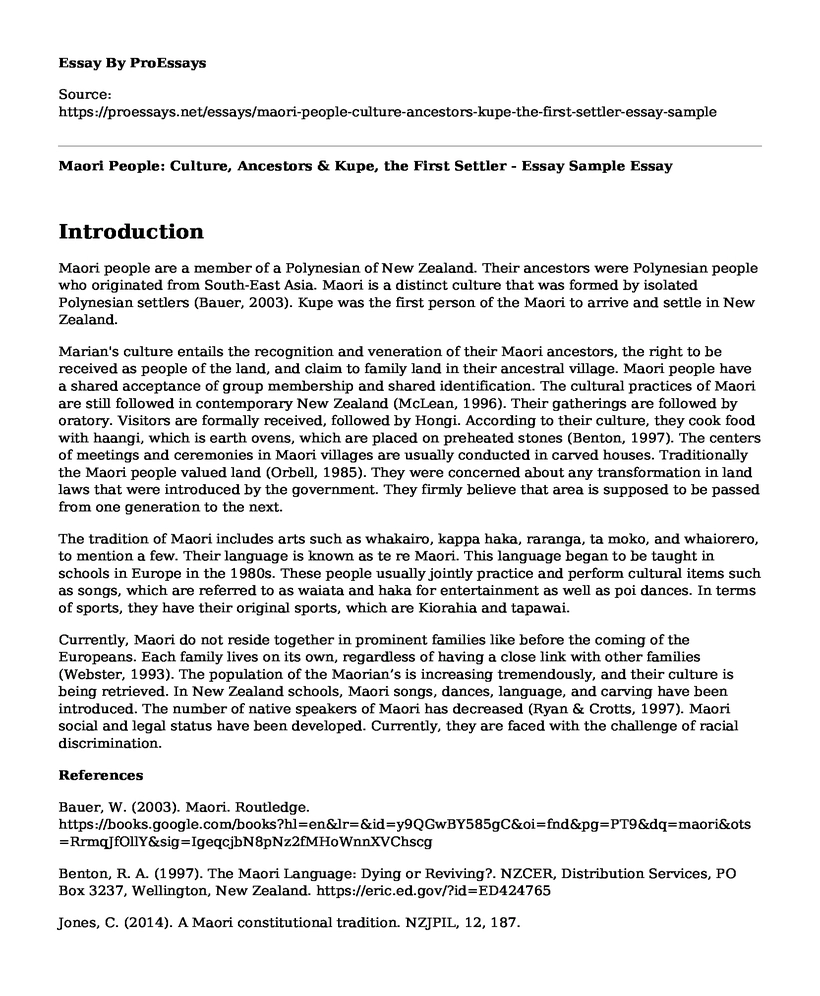Introduction
Maori people are a member of a Polynesian of New Zealand. Their ancestors were Polynesian people who originated from South-East Asia. Maori is a distinct culture that was formed by isolated Polynesian settlers (Bauer, 2003). Kupe was the first person of the Maori to arrive and settle in New Zealand.
Marian's culture entails the recognition and veneration of their Maori ancestors, the right to be received as people of the land, and claim to family land in their ancestral village. Maori people have a shared acceptance of group membership and shared identification. The cultural practices of Maori are still followed in contemporary New Zealand (McLean, 1996). Their gatherings are followed by oratory. Visitors are formally received, followed by Hongi. According to their culture, they cook food with haangi, which is earth ovens, which are placed on preheated stones (Benton, 1997). The centers of meetings and ceremonies in Maori villages are usually conducted in carved houses. Traditionally the Maori people valued land (Orbell, 1985). They were concerned about any transformation in land laws that were introduced by the government. They firmly believe that area is supposed to be passed from one generation to the next.
The tradition of Maori includes arts such as whakairo, kappa haka, raranga, ta moko, and whaiorero, to mention a few. Their language is known as te re Maori. This language began to be taught in schools in Europe in the 1980s. These people usually jointly practice and perform cultural items such as songs, which are referred to as waiata and haka for entertainment as well as poi dances. In terms of sports, they have their original sports, which are Kiorahia and tapawai.
Currently, Maori do not reside together in prominent families like before the coming of the Europeans. Each family lives on its own, regardless of having a close link with other families (Webster, 1993). The population of the Maorian’s is increasing tremendously, and their culture is being retrieved. In New Zealand schools, Maori songs, dances, language, and carving have been introduced. The number of native speakers of Maori has decreased (Ryan & Crotts, 1997). Maori social and legal status have been developed. Currently, they are faced with the challenge of racial discrimination.
References
Bauer, W. (2003). Maori. Routledge. https://books.google.com/books?hl=en&lr=&id=y9QGwBY585gC&oi=fnd&pg=PT9&dq=maori&ots=RrmqJfOllY&sig=IgeqcjbN8pNz2fMHoWnnXVChscg
Benton, R. A. (1997). The Maori Language: Dying or Reviving?. NZCER, Distribution Services, PO Box 3237, Wellington, New Zealand. https://eric.ed.gov/?id=ED424765
Jones, C. (2014). A Maori constitutional tradition. NZJPIL, 12, 187. https://heinonline.org/hol-cgi-bin/get_pdf.cgi?handle=hein.journals/nzjpubinl12§ion=13
McLean, M. (1996). Maori music. Auckland University Press. https://books.google.com/books?hl=en&lr=&id=GKnQRp_EafcC&oi=fnd&pg=PA1&dq=maori&ots=IolnO-ZpUW&sig=0rPgWMUSNC6glet9mKJjTcr2oDI
Orbell, M. (1985). Hawaiki: a new approach to Maori tradition (No. 35). Christchurch: University of Canterbury. https://pdfs.semanticscholar.org/617a/3a74cdd1bc340a217097b0ab21f2d4a5b9c2.pdf
Ryan, C., & Crotts, J. (1997). Carving and tourism: A Maori perspective. Annals of Tourism Research, 24(4), 898-918. https://www.sciencedirect.com/science/article/pii/S0160738397000522
Smith, S. P. (2011). Hawaiki: The original home of the Maori: With a sketch of Polynesian history. Cambridge University Press. https://books.google.com/books?hl=en&lr=&id=CGG7LR9t_wcC&oi=fnd&pg=PA9&dq=history,+culture+and+tradition+of+Maori&ots=n7cXwAKC8q&sig=GEbNjHDbja_tnUaGWE5u8NxJWi8
Webster, S. (1993). Postmodernist theory and the sublimation of Maori culture. Oceania, 63(3), 222-239. https://www.jstor.org/stable/40331335
White, J. (1888). The Ancient History of the Maori, vol. 1. Government Printer, Wellington.
White, J. (2011). The ancient history of the Maori, his mythology and traditions. Cambridge University Press. https://anthrosource.onlinelibrary.wiley.com/doi/abs/10.1525/aa.1989.91.4.02a00050
Cite this page
Maori People: Culture, Ancestors & Kupe, the First Settler - Essay Sample. (2023, Aug 14). Retrieved from https://proessays.net/essays/maori-people-culture-ancestors-kupe-the-first-settler-essay-sample
If you are the original author of this essay and no longer wish to have it published on the ProEssays website, please click below to request its removal:
- Conflict and Integration of Asian Culture and American Culture
- Lack of Diversity in the Boston Police Department Essay Example
- Essay Sample on Cultural Competence in Counseling: Essential for Successful Outcomes
- Essay Sample on Museums: Preserving Our World's History & Culture
- Paper Sample on a Mansion to Valuate: An Impromptu Visit
- Essay on Unconditional Love Beyond Blood Ties: A Story of My Life
- Cultural Diversity: Impact on Social Worker-Client Communication - Intentionality is Key - Essay Sample







